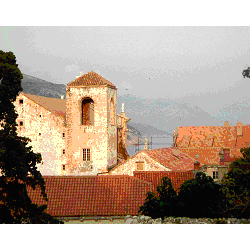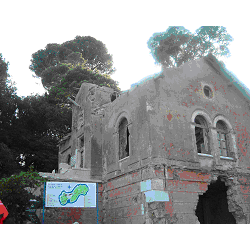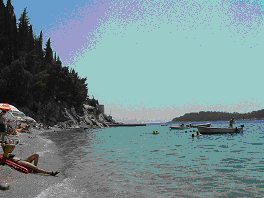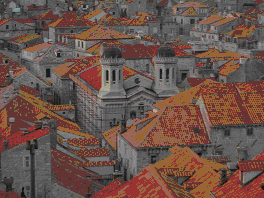 THE BELLS OF DUBROVNIK ring every hour and half hour, although they are silent throughout the night, when the local cats begin their hellish meows. From where I sat in the evening two summers ago, overlooking the city’s mosaic of pale-peach and red tiled roofs, I could admire a large sliver of Adriatic blue, sometimes speckled by imposing cruisers or elegant yachts that came and went.
THE BELLS OF DUBROVNIK ring every hour and half hour, although they are silent throughout the night, when the local cats begin their hellish meows. From where I sat in the evening two summers ago, overlooking the city’s mosaic of pale-peach and red tiled roofs, I could admire a large sliver of Adriatic blue, sometimes speckled by imposing cruisers or elegant yachts that came and went.
Croatia is a special place… Its coast is magnificent. I kept comparing: gorgeous Italy vis-à-vis this incredibly beautiful, but more pristine version of a Mediterranean coast…
Isle of Lokrum ruin, circa 1995
One of the saddest things to see were the gaping holes, some large, some small, sometimes many, sometimes few, on the façades of regular-looking buildings along the way… These are the scars of war left by the many bullets and shells on apartment complexes, houses overlooking the Adriatic, clusters of village dwellings… These wounds, unfortunately, are so recent, it’s almost embarrassing to remember! I mentioned to my sons that all of their contemporaries in Croatia were exposed to the horrors of war in the heart of Europe, while they were playing soccer with their classmates in Rome, having a wonderful and peaceful childhood, so very near by. Hard to believe - except for the physical scars on buildings - that Croatia experienced such savagery just a few years ago!
We visited the island of Lokrum, where the Benedictine monks settled many centuries ago, and where a few mortar shells landed a few years ago… Does the world remember?
A beautiful island 15 minutes away from Dubrovnik, Lokrum’s water at the time was very refreshing, crystalline as can be, and snorkeling in it was unbelievable. Something out of National Geographic: the waters were magnificent in what they delivered: underground gorges, multi-colored fish, and schools of gray and black fish…
On a cursory trip to Cartvat, an old city about 16 kms from Dubrovnik, we didn’t find the right beach (it was too crowded for my taste) and we went back to the little one we discovered a few days earlier, which once held a big hotel and apartment complexes, and which are now boarded up because of the gunfire they withstood…modern monuments to modern disasters… I liked the guy who had the concession stand and sold us ice cream (50% cheaper than in Dubrovnik)…
The days we spent in Dubrovnik and its surroundings were beautiful and I know, for certain, that I shall remember this place forever: it is a gem. The white marble of the city’s buildings, staircases, and streets absorbed the heat, so that in the evening one could feel the warmth irradiating from the marble streets and the building walls.
To anyone who ever wants to begin to understand how we could have had such a savage war in the heart of Europe, I recommend reading The Bridge over the Drina. It is a beautiful story written by a Nobel Laureate, a former Yugoslav diplomat, Ivo Andric. With poignant melancholy, it recounts the traumas and tragedies, joys and woes, loves and hatreds of a multi-ethnic, multi-cultural, multi-religious multitude in a town in Bosnia, from the Middle Ages until the outbreak of World War I. It is a formidable epic, and the perfect book to read in Croatia!
The peach tiles of Dubrovnik…
68% of the rooftops were destroyed during the 1990’s war,
and the dark tiles are the new replacements…

[Croatia] [Dubrovnik] [Lokrum] [Vinko Coce] [Drina] [Andric]












No comments:
Post a Comment